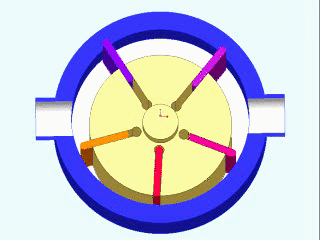Rotary pumps trap fluid in a closed casing and discharge a smooth flow. They can handle almost any liquid that does not contain hard and abrasive solids, including viscous liquids. They are also simple in design and efficient in handling flow conditions that are usually considered too low for economic application of centrifuges.

Types of rotary pumps include cam-and-piston, internal-gear, lobular, screw, and vane pumps. Gear pumps are found in oilfired home heating systems.
Rotary pumps find wide use for viscous liquids. When pumping highly viscous fluids, rotary pumps must be operated at reduced speeds, because at higher speeds the liquid cannot flow into the casing fast enough to fill it.
Unlike a centrifugal pump, the rotary pump will deliver a capacity that is not greatly affected by pressure variations on either the suction or discharge ends. In services where large changes in pressure are anticipated, the rotary design should be considered.